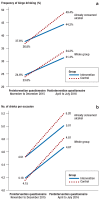Preventing Binge Drinking in Adolescents
- PMID: 28502313
- PMCID: PMC5437261
- DOI: 10.3238/arztebl.2017.0280
Preventing Binge Drinking in Adolescents
Abstract
Background: In a survey taken in Germany in 2015, 14.1% of the 12- to 17-year-olds surveyed had practiced binge drinking at least once in the preceding 30 days. The school program "Klar bleiben" ("Keep a Clear Head") was designed for and implemented among 10th graders. The participants committed themselves to abstain from binge drinking for 9 weeks. We studied whether this intervention influenced the frequency and intensity of binge drinking.
Methods: This cluster-randomized controlled trial was carried out in 196 classes of 61 schools, with a total of 4163 participants with a mean age of 15.6 years (standard deviation 0.73 years). Data were collected by questionnaire in late 2015, before the intervention and again six months later. The primary endpoints were the frequency of consumption of at least 4 or 5 alcoholic drinks (for girls and boys, respectively) and the typical quantity consumed. This trial was registered in the German Clinical Trials Registry (Deutsches Register Klinischer Studien, DRKS) with the DRKS ID number DRKS00009424.
Results: At the beginning of the trial, there was no difference between the intervention group and the control group with respect to the primary endpoints. After the intervention, differences were found among participants who had consumed alcohol before the trial (73.2% of the overall sample): binge drinking at least once in the preceding month was reported by 49.4% of the control group and by 44.2% in the intervention group (p = 0.028). The mean number of alcoholic drinks consumed in each drinking episode was 5.20 in the control group and 5.01 in the intervention group (p = 0.047).
Conclusion: The intervention was effective only in the large subgroup of adolescents who had previously consumed alcohol: they drank alcohol less often and in smaller amounts than their counterparts in the control group.
Figures



References
-
- De Matos EG, Atzendorf J, Kraus L, Piontek D. Substanzkonsum in der Allgemeinbevölkerung in Deutschland. Sucht. 2016;62:271–281.
-
- World Health Organization. World Health Organization. Geneva: Global status on alcohol and health—2014.
-
- GBD 2015 Risk Factors Collaborators. Global, regional, and national comparative risk assessment of 79 behavioural, environmental and occupational, and metabolic risks or clusters of risks, 1990-2015: a systematic analysis for the Global Burden of Disease Study 2015. Lancet. 2016;388:1659–1724. - PMC - PubMed
Publication types
MeSH terms
LinkOut - more resources
Full Text Sources
Other Literature Sources

